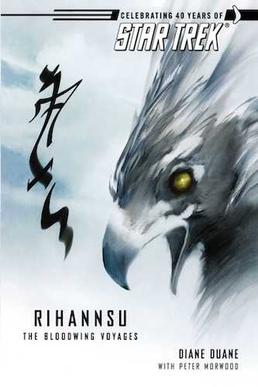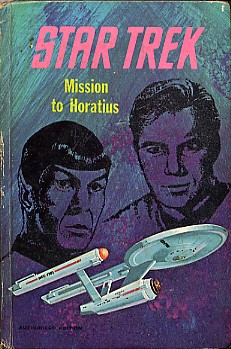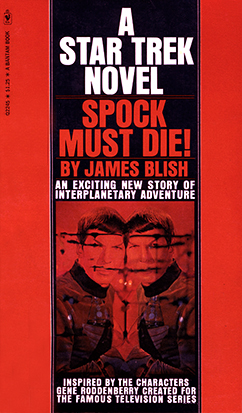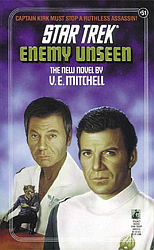
Star Trek: The Animated Series (TAS), is an American animated science fiction television series created by Gene Roddenberry. It originally aired under the title simply as Star Trek, subtitled Created by Gene Roddenberry, on Saturday mornings from September 8, 1973, to October 12, 1974, on NBC, spanning 22 episodes over two seasons. The second series in the Star Trek franchise, it features mostly the same characters as Star Trek: The Original Series. Set in the 23rd century, when Earth is part of a United Federation of Planets, it follows the adventures of the Starfleet vessel USS Enterprise as it explores the Milky Way galaxy.

The Romulans are an extraterrestrial race in the American science fiction franchise Star Trek. They first appeared in the series Star Trek (1966–1969). They have appeared in most subsequent Star Trek releases, including The Animated Series, The Next Generation, Deep Space Nine, Voyager, Enterprise, Discovery, Picard, Strange New Worlds, and Lower Decks. They appear in the Star Trek feature films Star Trek V: The Final Frontier (1989), Star Trek VI: The Undiscovered Country (1991), Star Trek: Nemesis (2002) and Star Trek (2009). They also appear in various other spin-off media, including books, comics, toys and games.

Vulcans, sometimes referred to as Vulcanians, are a fictional extraterrestrial humanoid species in the Star Trek universe and media franchise. In the various Star Trek television series and films, they are noted for their attempt to live by logic and reason with as little interference from emotion as possible. Known for their pronounced eyebrows and pointed ears, they originate from the fictional planet Vulcan. In the Star Trek universe, they were the first extraterrestrial species to make contact with humans.

Spock is a fictional character in the Star Trek media franchise. He first appeared in the original Star Trek series serving aboard the starship USS Enterprise as science officer and first officer and later as commanding officer of the vessel. Spock's mixed human-Vulcan heritage serves as an important plot element in many of the character's appearances. Along with Captain James T. Kirk and Dr. Leonard "Bones" McCoy, he is one of the three central characters in the original Star Trek series and its films. After retiring from active duty in Starfleet, Spock served as a Federation ambassador, and later became involved in the ill-fated attempt to save Romulus from a supernova, leading him to live out the rest of his life in a parallel universe.

Nyota Uhura, or simply Uhura, is a fictional character in the Star Trek franchise. In the original television series, the character was portrayed by Nichelle Nichols, who reprised the role for the first six Star Trek feature films. A younger Uhura is portrayed by Celia Rose Gooding in the 2022 prequel series Star Trek: Strange New Worlds, while an alternate timeline version of Uhura has been portrayed by actress Zoe Saldaña in the feature films Star Trek (2009), Star Trek Into Darkness (2013), and Star Trek Beyond (2016).
"The City on the Edge of Forever" is the twenty-eighth and penultimate episode of the first season of the American science fiction television series Star Trek. Written by Harlan Ellison, contributors and/or editors to the script included Steven W. Carabatsos, D. C. Fontana and Gene L. Coon. Gene Roddenberry made the final re-write. The episode was directed by Joseph Pevney and first aired on NBC on April 6, 1967, with a repeat broadcast on August 31, 1967.

Saavik is a fictional character in the Star Trek universe. She first appeared in the film Star Trek II: The Wrath of Khan (1982) played by Kirstie Alley. Robin Curtis took over the role for Star Trek III: The Search for Spock (1984) and Star Trek IV: The Voyage Home (1986).

"Unification" is a two-part episode of the syndicated American science fiction television series Star Trek: The Next Generation which features Leonard Nimoy as Spock. The first of the two episodes earned a 15.4 household Nielsen rating, drawing over 25 million viewers, making it one of the most watched episodes in all seven seasons of The Next Generation's run.
"The Infinite Vulcan" is the seventh episode of the first season of the American animated science fiction television series Star Trek: The Animated Series. It first aired on NBC on October 20, 1973, and was written by Original Series cast member Walter Koenig. It was the actor's only involvement in the series, as he had not been hired to voice Pavel Chekov in the animated version due to budgetary limitations. With "The Infinite Vulcan", Koenig became the first member of the Star Trek cast to write an episode for the franchise. As with the rest of the first season, the episode was directed by Hal Sutherland.

Star Trek: Rihannsu is a series of interlinked novels, written by Diane Duane and Peter Morwood, published by Pocket Books from 1984 to 2006. The series name was retroactively applied to the first novels with the release of new installments in 2000. A fifth novel was published in 2006.
"The Enterprise Incident" is the second episode of the third season of the American science fiction television series Star Trek. Written by D. C. Fontana and directed by John Meredyth Lucas, it was first broadcast September 27, 1968.

Kirk/Spock, commonly abbreviated as K/S or Spirk and referring to James T. Kirk and Spock from Star Trek, is a pairing popular in slash fiction, possibly the first slash pairing, according to Henry Jenkins, an early slash fiction scholar. Early in the history of Star Trek fan fiction, a few fan writers started writing about a romantic and sexual relationship between Kirk and Spock, highlighting a romantic or sexual element to the friendship between the men. As of 1998, most academic studies on slash fiction focused on Kirk/Spock, as Star Trek was by that point one of the longest-lived and most prosperous subjects of slash fiction, while its mainstream popularity made it one of the most accessible titles for academics and their audience. As the first slash pairing, K/S was created and developed largely independently from the influence of other slash fiction, with most of the conventions of the slash genre seeing their debut first in K/S slash.

Mission to Horatius is a novel based on the American science fiction television series Star Trek: The Original Series. It was published in 1968 by Whitman, and was the first original novel based on the series; the first novel for adult audiences, Spock Must Die!, was not published until February 1970. Mission to Horatius details the adventures of the crew of the U.S.S. Enterprise investigating where a distress signal had originated, resulting in them engaging with several different human colonies.

Spock Must Die! is an American science fiction novel written by James Blish, published February 1970 by Bantam Books. It was the first original novel based on the Star Trek television series intended for adult readers. It was preceded by a tie-in comic book line published by Gold Key and the novel Mission to Horatius by Mack Reynolds, all intended for younger readers.

The Price of the Phoenix is a science fiction novel by American writers Sondra Marshak and Myrna Culbreath, based upon the 1960s television series Star Trek. It was first published by Bantam Books in 1977, and reissued by Corgi and Titan Books in the UK.
"The Survivor" is the sixth episode of the first season of the American animated science fiction television series Star Trek: The Animated Series. It first aired on NBC on October 13, 1973, and was written by James Schmerer and was directed by Hal Sutherland. Schmerer pitched an idea for an episode to producer D.C. Fontana called "The Chameleon", and together with the series creator Gene Roddenberry, it was developed into the final script.

Web of the Romulans is a Star Trek: The Original Series novel written by M. S. Murdock. The subplot where the Enterprise falls in love with Captain James T. Kirk was taken from a story that Murdock had originally written for a Star Trek fanzine.

The Pandora Principle is a science fiction novel by American writer Carolyn Clowes, part of the Star Trek: The Original Series. It features the origin story of Saavik, and how she came to know Spock.

Enemy Unseen is a Star Trek: The Original Series novel written by V.E. Mitchell.
















